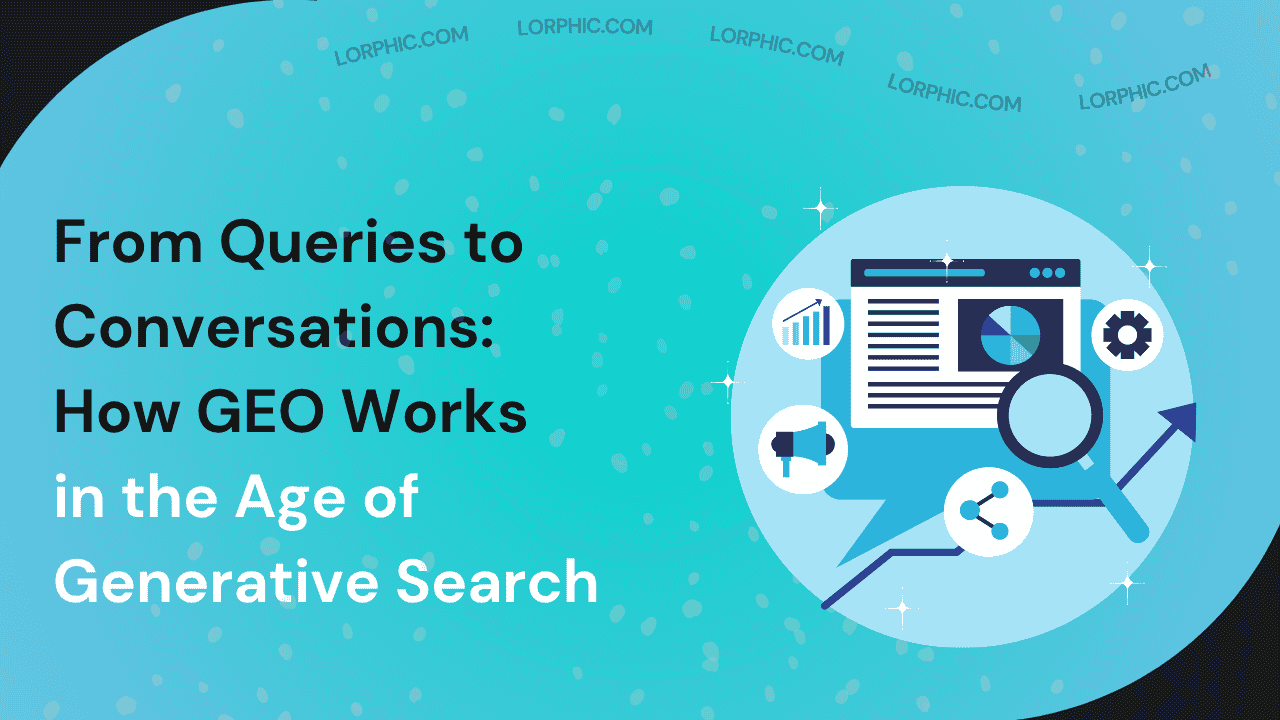Search is evolving faster than ever before. We have entered a time where people no longer just type a few words into a search bar. Instead, they ask full questions and hold conversations with artificial intelligence tools such as ChatGPT, Google’s Search Generative Experience, and Perplexity to get instant, clear, and natural answers.
In this new era of generative search, the traditional methods of Search Engine Optimization are no longer enough. This is where Generative Engine Optimization, also known as GEO, plays an important role. It focuses on making your content more visible and valuable to AI systems so that it appears directly in the responses users receive, not only in standard search results. In this blog, you will learn what Generative Engine Optimization is, how does GEO work, and how you can optimize your content to stand out in the growing world of AI-driven search.
What is GEO?
Generative Engine Optimization (GEO) is a new way of making your content visible in the world of AI-powered search. It’s about helping tools like ChatGPT and Google’s Search Generative Experience (SGE) easily find, understand, and use your content when they create answers for users.
Think of it this way, SEO helps your content rank higher on Google, while GEO helps your content get recognized and mentioned by AI systems. So, when someone asks questions like “What is Generative Engine Optimization?” or “Which GEO tools are best for startups?”, these AI tools search across the internet to find information that’s clear, accurate, and well-structured.
That’s where GEO comes in. If your content is written naturally, well-organized, and focused on providing real value, it’s more likely to show up in those AI-generated responses.
In simple terms, GEO makes your content part of the conversation. It’s not just about being seen anymore, it’s about being understood and referenced by the intelligent systems shaping how people search for information today.
How Does GEO Work?
To grasp how Generative Engine Optimization functions, you first need to understand how AI-based search engines interpret information. Unlike traditional search systems that depend on exact keyword matches, generative engines use artificial intelligence and language models to understand the meaning, purpose, and context behind a query. They then gather insights from reliable sources and present a clear, conversational response.
When your content is accurate, well-structured, and easy to read, AI engines are far more likely to include it within their generated answers. According to the GEO research paper, generative engines synthesize content from multiple sources and embed cited references; the paper notes that including quotations, statistics, and clear citations can boost a source’s visibility by up to 40%. The framework treats visibility more richly than mere ranking, considering where and how a citation appears.
Content Quality and Organization
High-quality and well-organized content is the foundation of effective GEO. Generative engines favor information that’s simple to follow, logically structured, and naturally written. To make your content GEO-friendly, focus on answering user questions directly, breaking information into short sections, and using headings or bullet points for clarity. Write conversationally, as if you’re explaining the concept to someone new to the topic.
Subject Matter Expertise
Authority and experience play a huge role in GEO. AI systems tend to highlight content that demonstrates expertise and depth of understanding. You can show your knowledge by sharing real examples, referencing credible professionals, or including verified data. Use accurate terminology but explain it in a way that’s easy for readers to grasp. The more your content reflects real-world knowledge and authenticity, the more likely AI models are to treat it as a reliable reference for answering complex queries.
Technical Performance and Optimization
Even in the age of generative search, technical performance remains a key factor. A fast, responsive, and accessible website ensures both users and AI systems can easily navigate your content. Structured data is particularly powerful, it helps AI engines understand what each page represents, whether it’s a guide, product, or service. Additionally, make sure your metadata, internal links, and overall site structure are well-optimized. A technically strong foundation increases your chances of being recognized and featured by AI systems.
AI-Based Insights and Analysis
What makes GEO truly innovative is its data-driven approach. Instead of relying only on keyword rankings, GEO measures how often your content appears or is referenced in AI-generated summaries. By using tools that monitor AI visibility and track user engagement, you can better understand how your content performs within conversational search results. Paying attention to how users phrase their questions helps you refine your content so it aligns with the way AI tools interpret and generate answers.
Emphasis on References and Mentions
Trust and credibility are the cornerstones of GEO success. Generative engines prefer content that comes from reputable, transparent, and consistently cited sources. You can strengthen your authority by including trustworthy references, earning mentions from respected industry sites, and showcasing author details or credentials. Keeping your content updated and well-researched not only builds reader confidence but also signals to AI systems that your website is a dependable source of factual and valuable information.
How to Make Your Content GEO-Friendly?
Now that you understand how GEO works, it is important to know how to make your content more visible and useful for AI systems. GEO-friendly content is designed to be easy for both humans and AI tools to read, understand, and trust. By following a few key practices, you can improve your chances of being included in AI-generated answers and increase your online authority.
- Write Like You Talk: Generative engines respond best to content that is natural and conversational. Avoid complicated words and keyword stuffing. Use short sentences, simple words, and a tone that feels like you are explaining something to a friend. For example, instead of saying “Generative Engine Optimization strategies enhance AI-based visibility,” you could say “Using GEO helps your content appear when AI tools like ChatGPT answer questions.”
- Use Question-Based Headings: People often ask full questions when interacting with AI tools. Creating headings that reflect these questions helps your content match real user intent. Examples include “What is the difference between GEO and SEO” and “How does Generative Engine Optimization work.” This approach makes it easier for AI systems to identify your content as a relevant answer.
- Keep Answers Short and Clear: AI tools prefer concise answers that summarize information clearly. Focus on key points and avoid overly long explanations. For example, “GEO services help businesses make their content easy for AI tools to find and understand.” Clear and brief answers are more likely to be picked up by AI engines.
- Add Facts and Sources: Support your content with credible information such as research, examples, or verified data. AI systems prioritize content that can be trusted. Linking to recognized sources or experts increases your credibility and signals to AI tools that your content is reliable.
- Update Regularly: Keeping your content current is essential. Refresh older posts with new information, examples, or statistics. Updated content is more likely to be referenced in AI-generated responses and helps maintain your authority in the field.
By following these practices, your content becomes easier to understand, more trustworthy, and more likely to be included in AI-driven search results, helping you reach a wider audience and build authority.
Challenges of GEO (Generative Engine Optimization)
Generative Engine Optimization offers exciting opportunities, but it also comes with unique challenges that businesses need to consider.
Limited Analytics
Tracking how and when AI tools reference your content is still difficult. Unlike traditional SEO, where metrics like clicks and rankings are easy to measure, GEO lacks widely available analytics, making it harder to quantify your success in AI-generated results.
Reduced Direct Traffic
As AI engines provide instant answers, users may get the information they need without visiting your website. This can lead to lower direct traffic, even if your content is widely used by AI systems.
High Competition for Authority
AI tools tend to cite only trusted and credible sources. This means your content must be accurate, well-researched, and authoritative to have a chance of being included in AI-generated responses. Quality and credibility are more important than ever.
Constant Change
The world of generative AI evolves rapidly. New algorithms, updates, and models can change how content is evaluated and cited. GEO strategies require regular updates to remain effective and relevant.
Despite these hurdles, Generative Engine Optimization has enormous potential for businesses that embrace it early. By focusing on high-quality content, clear structure, and authority, brands can position themselves as reliable sources in the emerging AI-driven search landscape.
Conclusion
The shift from simple searches to conversational interactions is transforming the way we approach online visibility. Generative Engine Optimization is not just a trend, it represents the next level of making your content accessible, understandable, and useful for AI-powered tools.
By prioritizing clear writing, subject matter expertise, and authentic insights, you can ensure your brand stays visible and trusted in this evolving digital landscape. Success in the age of generative search is no longer only about ranking high in search results. It is about creating content that AI systems can understand, rely on, and confidently share with users.
Brands that embrace GEO today position themselves to be recognized, referenced, and valued in the new era of AI-driven discovery, ensuring long-term relevance and authority.
FAQ’s
How does Generative Engine Optimization work?
GEO works by making your content easy for AI tools to read and summarize. It uses structured data, conversational writing, and accurate facts to ensure that AI systems recognize your content as a reliable source when generating answers.
What is GEO in digital marketing?
In digital marketing, GEO (Generative Engine Optimization) is the practice of optimizing content so that AI-powered search tools can find, understand, and reference it in their answers. Unlike traditional SEO, which focuses on ranking web pages in search results, GEO focuses on making your content visible and trustworthy for AI-driven conversational searches.




